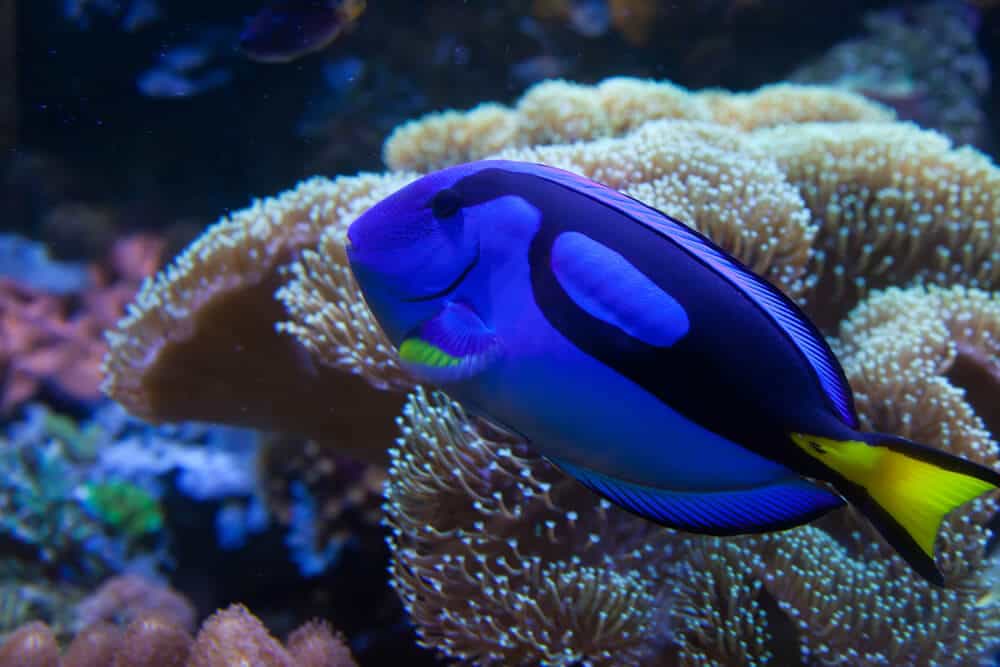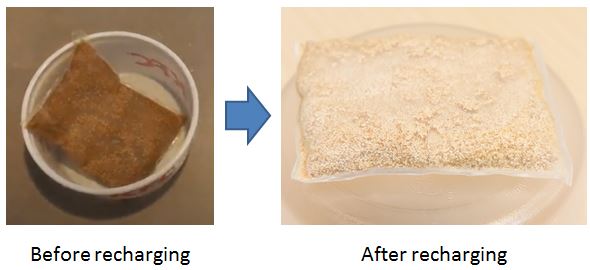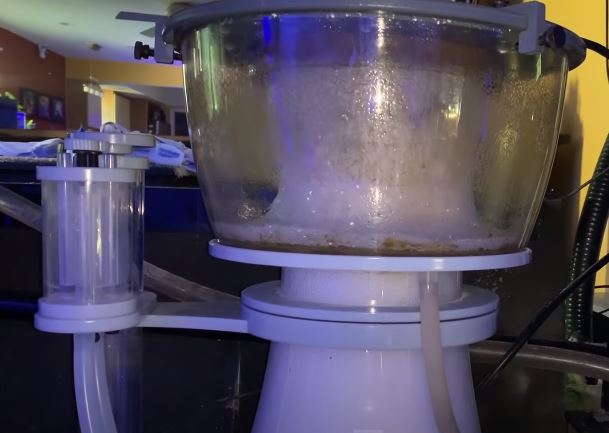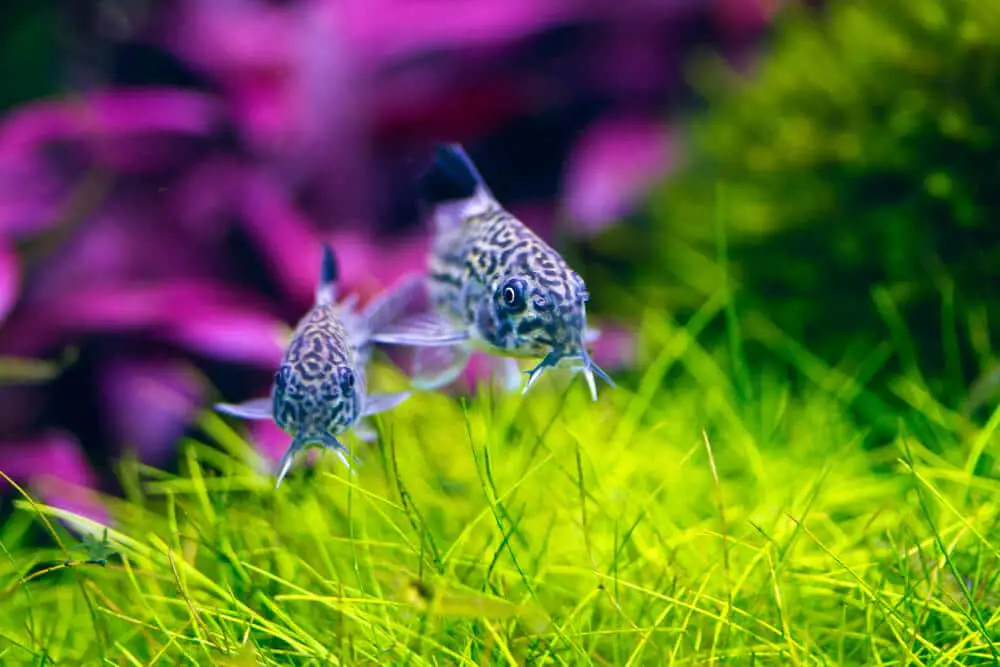
No one wants a cloudy fish tank or sick fish. Instead, all of us fish keepers want a brilliant, sparkling tank. We want healthy fish so we can enjoy watching them. Great filtration is one of the most important parts of making an attractive tank that keeps your fish hale and hearty.
In this article, we’re going to show you the basics of a good filter setup. Then we’ll give you five great choices for buying an HOB filter for your tank. We’ve included a helpful chart to give you a side-by-side comparison of all five filters.
After we announce our top choice, we’ll answer a few of the common questions people have about Hang on Back Filters.
See also: Check out our guide featuring the other aquarium filter types.
Contents
5 Best HOB Filter Review
Now, let’s take a closer look at the top five best hang on back filters. When we’re done, we’ll tell you which one we would choose.
1. Aqua Clear – Fish Tank Filter

The first filter on our list is the Aqua Clear series of filters. These are numbered 20,30,50,70, and 110 to correspond to increases in the tank size, measured in gallons, for which the filter is suitable. Aqua Clear is a world-renowned maker of aquarium supplies. This filter will not disappoint you!
Aqua Clear has created a filter designed to lengthen the time your water is in contact with the filter. Water is pumped through the intake and into the bottom of the filter chamber. The water then rises through a series of filter pads before falling down a waterfall into the tank. Extending the length of filtration helps remove impurities. It also lengthens the time available for bacteria to break down ammonia and nitrite.
The magnetic impeller motor is very durable. Returns due to motor failure are almost unheard of. Once set up correctly, the motor is very quiet, and the sound of the waterfall is easily heard.
Adjustable flow control makes caring for your fish simple. Aqua Clear’s flow adjustment doesn’t reduce the speed of the motor but changes the volume of water being moved. This allows for maximum filtration, even at lower water speeds.
Maintaining the filter is very easy. The lid opens to allow easy removal of the filter basket. Replacement filters are needed as often as once a month for the activated carbon. They can be purchased easily on Amazon.
We’d like to see a clog indicator on this filter. This might help slightly less attentive fish keepers to remember to change the filters. A self-priming function would also be a nice addition to this otherwise brilliant unit.
Apart from these minor improvements, this filter is everything you could want in a simple design.
Pros:
- Highest filtration quality with the largest filter media volume.
- Adjustable flow rate
- Can be used with other filter media
- Suitable for tanks up to 110 gallons
- Very high customer ratings
- Great value for money
Cons:
- Not self-priming
- No clog indicator
2. Fluval C Power Filter

Fluval is another widely recognized aquarium brand. Their C-series filters have been on the market for years and have earned a great name for themselves. They are powerful, relatively quiet, and are some of the most durable filters available.
The main selling point is Fluval’s 5-stage filtration system. Water passes through these stages on its way through the filter:
- Coarse Foam Pad – The first stage removes the largest particles from the water. This is where the fish poo and other dirt is most likely to be captured.
- Fine Foam Pad – Following the coarse pad, the finer foam snags smaller particles and breaks up micro-bubbles in the water.
- Activated Carbon Insert – Activated carbon has a huge surface area compared to its volume. This is ideal for removing unwanted odors, discolorations, or other chemical impurities.
- Bio-Screen – A portion of the water is diverted to pass through this bio-screen. This extra step ensures better water distribution in the final portion of the filtration process.
- C-Nodes – The Fluval’s C-Nodes are biological filter media. These star-shaped inserts promote the growth of beneficial bacteria to process ammonia.
All these stages add up to very clear water and happy fish.
Fluval has also created a flow rate adjustment system to maximize efficiency. When the flow rate is reduced, up to 50% of the water is recirculated through the filtration chamber. This ensures the water is clean and clear even when the flow rate is reduced for breeding or feeding.
To make this filter even better, we’d like to see a self-priming feature. This would assist in maintenance. It would also be nice to see a bigger tank capacity since this is limited to tanks smaller than 70 gallons.
Still, these minor drawbacks don’t take away from the quality of this superb filter.
Pros:
- High build quality
- High filtration quality with large filter media volume
- Adjustable flow rate
- Clog indicator
Cons:
- Not self-priming
- Expensive
- Limited to tanks smaller than 70 gallons
3. MarineLand Penguin 350 BIO-Wheel Power Filter

The Penguin 350 is one of the more attractive filters on the market. Many people are mesmerized by the sight of the spinning bio wheels. This extra interest enhances the beauty of your fish tank.
Apart from its physical appeal, the Penguin 350 is also a great filter. MarineLand has produced filters for more than 40 years. Their designs are reliable and work well for many thousands of aquariums.
An intake tube pulls water from the tank into the body of the filter. Once inside, water passes through three stages of filtration.
First, a Rite-Size filter floss cartridge traps particles and dirt.
Second, water is passed through the Black Diamond activated carbon pad. This cleans chemical impurities from the water.
Third, as the water leaves the filter, it flows through a third filtration stage. Here is where the bio wheels come into action. These work like water wheels, turning as the water passes over them. They add biological filtration to the setup and assist the nitrogen cycle in your tank.
The mid-filter allows for some control of the flow rate. This is very helpful for managing water movement around smaller tanks.
Some improvements could be made by adding a clog indicator and self-priming function. Even without these, the Penguin 350 receives great feedback from customers. As the cheapest filter on our list, it’s a great purchase.
Pros:
- The cheapest filter
- Long warranty period
- Adjustable flow rate
- Highest customer ratings
Cons:
- Not self-priming
- No clog indicator
- Limited to tanks smaller than 70 gallons
4. Aqueon QuietFlow LED PRO Aquarium Power Filters

Some people don’t want to hear their fish tank equipment. The Aqueon QuietFlow filter series is perfect for those who want a silent setup. The filter’s motor sits down inside the tank. This allows the water to muffle sound effectively.
The motor is not loud when set up properly. This is also a self-priming pump, so no extra water is required during installation or maintenance.
Quick tip:
Air can become trapped in the impeller and this can lead to extra noise. Adding a little water into the filter or switching it off and on rapidly a few times should clear this problem.
The filter includes three filtration stages.
First, dense floss pads remove unwanted debris.
Following this, an activated carbon pad eliminates unwanted odors and chemicals.
Finally, the water passes through a ‘bio-holster.’ This biological filter promotes the nitrogen cycle by giving a platform on which ammonia-converting bacteria will grow.
Another aspect of the quiet design is the final segment of the filter. Water passes through the first three stages and then moves into another sponge pad. This coarse pad, called a diffuser grid, reduces the amount of noise created by the water returning to the tank.
Aqueon has included a clog indicator in the design of this self-priming pump. This helpful feature lets you know when it’s time to change the filters. We’d like to see a longer warranty and an adjustable flow rate, though.
Pros:
- Quietest HOB filter
- Self-priming
- Clog indicator
Cons:
- Unable to adjust flow rate
- Short warranty period
5. Penn Plax Cascade Hang-on Aquarium Filter
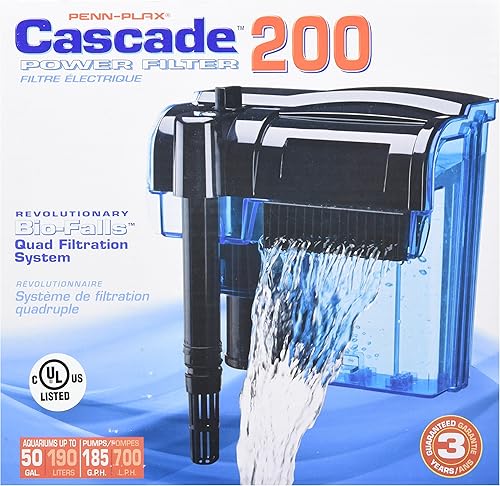
Our final entry is the Penn Plax Cascade filter. This nifty little package is great for providing simple filtration options for tanks of different sizes. The Cascade 300 moves enough water to service tanks as large as 100 gallons. The smallest filter, the Cascade 20, is great for small tanks up to seven gallons in size.
One of the best features of these filters is their adjustable flow rate. Small tanks and delicate fish need a lower water flow. The Cascade 20 is perfect for small tanks and gentle fish, such as Betta. The low flow will not stress the fish or disturb the substrate.
Filtration is achieved by pour watering through a sponge system, followed by an activated carbon cartridge. The water then passes through the Bio-Falls Quad Filtration system. This system is designed to circulate oxygen in the water while also allowing bacteria to grow and remove ammonia and nitrite from the tank.
We really like the adjustable flow rate and the extended warranty. However, this filter could be improved with the addition of a self-priming function, a clog indicator, and better biological filtration for smaller tanks.
Pros:
- Longest warranty period
- Adjustable flow rate
- Suitable for tanks up to 100 gallons
Cons:
- Not self-priming
- No clog indicator
- Low customer ratings
- No biological filter media for small tanks
Buyer’s guide to Hang on Back filters
Hang on back filters are known as HOB filters or power filters. Many people choose these instead of in-tank filters because they are easier to maintain. They also stay out of sight behind the tank. Together, this makes your tank more attractive and less work.
However, filters are like fish. There are dozens of different varieties. They are described in various ways. The language can get a bit confusing. We’re here to help you with our simple buyer’s guide.
Here are the top six things we think you can think about to help make the best choice.
#1: Filtration Flow Rate and Tank Size
Flow rate is very important for tank health.
If your flow rate is too low, then waste will build up in the poorly filtered tank.
Too much filtration could lead to a fast water flow. This can harm small shrimp and placid fish, such as Bettas.
Filtration flow rate is measured in gallons per hour (or liters per hour for those outside the USA). The HOB filter which will work best for your tank will move at least four times the volume of your tank each hour.
For example, if you have a 20-gallon tank, then your filter should move at least 80 gallons of water each hour.
The manufacturer specs are always optimal or maximum. The amount of water being moved may change. Some filters are adjustable.
All filters will have reduced flow rate due to dirt and particles. So it’s better to choose a filter that moves 4-5 times the volume of your tank to be sure your filtration is good enough.
#2: Filtration quality
Filtration quality is hotly debated. Filter manufacturers all make grand claims about their products. Some of these claims are even true! We want to provide you with some simple guidelines for choosing the best filter.
There are two designs of HOB filters to think about.
- The first is a chamber filter. These are designed to use filter media, such as sponges and filter floss, inserted into the chamber.
- The second type is a cartridge filter. Cartridge filters are built to use the manufacturer’s cartridges.
Which of these is better for your tank?
The primary purpose of your filter is to do a couple of things:
First, it should trap waste and debris so you can remove them. Fish poo and debris will get stuck in your filter and later removed as you clean the filter or replace its media.
Second, and more important, the filter provides a place for biological filtration.
Here is a quick review of the nitrogen cycle in your tank. Fish waste converts to ammonia. The ammonia is consumed by one type of bacteria and converted to nitrite. Another type of bacteria consumes the nitrite and converts it to nitrate. Both ammonia and nitrite are harmful to your fish at even small levels. Nitrate is also harmful, but fish can tolerate a moderate level of nitrate.

The Aqua Clear filter, for example, has a chamber several times thicker than cartridge filters.
#3: Extra functions
Filters are sold with many bells and whistles. Some of these might be worth considering for your next filter.
Adjustable flow rate
Delicate fish and plants require a lower flow rate in the tank. Being able to adjust the flow can help you do what is best for your fish.
Also, if you want to breed fish, then turning down the flow rate during breeding will help achieve success.
Clogging indicator
Most filters fill up with dirt at some point. You will soon be able to tell just by looking at your tank if this has occurred.
However, some filters make this even easier. They tell you when the filter is clogged. We think anything that makes tank maintenance easier is a big bonus.
Self-priming
Filter impellers are designed to run while full of water. Self-priming filters do not require you to pre-fill them before activating the filter.
Priming a filter isn’t difficult, but why add extra work? Again, anything that makes tank maintenance easier is a big bonus.
Loudness
We all want to see our fish tanks. We don’t want to hear our tank filters. Achieving silent filtration is almost impossible due to the impeller running. However, some filters are quieter than others. This may be important to you based on where your tank is set up.
#4: Warranty
Filters don’t have too many moving parts. Many of them work for years without any problems.
However, a good warranty will help you if a problem does occur. Longer warranties are better. Also, you can look for filters with a trial period or good returns policy.
#5: Customer Ratings
As an aquarium keeper, you are part of a worldwide family of fish lovers. Read what others say about their filters. Try to find reviews from customers whose tanks are set up like yours. Their thoughts may help you choose the best power filter.
#6: Price
Brand names can make a big difference to price in the fishkeeping world. Brands such as Fluval command a premium price tag. If you can afford it, then buy the best. We can show you how to optimize your filters to get the best performance even if you buy a slightly less expensive choice.
Comparison table
Below is a table that we made to help you compare the features of each filter. You’ll find the information presented clearly and simply to help you make a quick comparison.
Parameters/Features
- 2. Filtration quality
- Filter media volume
- Water & filter media contact time
- Ability to add/use other filter media
- Filter type
- 3. Extra functions/features:
- Adjustable flow rate
- Clog indicator
- Self-priming
- Loudness
- 4. Warranty (from date of purchase)
- 5. Average customer rating
- 6. Price
- 7. Best feature

Aqua Clear HOB Filter
- large
- long
- Chamber inserts
- normal
- 2 years
- highest
- normal
- Highest Filtration Quality
Fluval C Power Filter
- large
- long
- Chamber inserts
- normal
- 2 years
- high
- most expensive
- Most Durable
MarineLand Penguin
- small
- short
- Cartridge
- normal
- 3 years
- highest
- cheapest
- Cheapest
Aqueon QuietFlow
- small
- short
- Cartridge
- quietest
- 1 year
- high
- normal
- Quietest
Penn Plax Cascade
- small
- short
- Cartridge
- normal
- 3 years
- low
- normal
- Easy to Modify
Our Best HOB Filter
Best Value HOB filter: Aqua Clear
The Aqua Clear Filter is our top choice. Its filtration quality is superb. The adjustable flow rate increases this filter’s flexibility.
Also, being able to use other filter media enhances the filter’s capabilities. We think, for the money, this is the best power filter you can buy.
Do you want Aqua Clear HOB Filter?
Another option: Fluval C Power Filter
For those who don’t mind paying extra for a few bless and whistles, the Fluval C Power Filter could be a good choice. Fluval’s filtration quality is much better than other filters for the reasons we described above.
The clog indicator will remind you of the need for maintenance. Fluval parts and accessories are widely available. Buying new pads and filter media will be easy.
Do you want Fluval C Power Filter?
HOB Filters FAQ
People ask many questions about HOB filters. Here, we’re going to answer some of the most common questions we receive.
What is an HOB filter?
There are three places a filter can go: in the tank, on the tank, and below the tank.
Internal filters sit inside the tank. HOB filters fit onto the tank’s rim and are usually positioned at the back of the tank. Canister filters and sumps are larger and sit below the tank (or somewhere else nearby) and are connected by hoses.
So, an HOB filter is a water filtration system that hangs on the back of the aquarium.
How does an HOB filter work?
Generally, HOB filters work by drawing water through an intake tube into the filter chamber. Inside the filter chamber, the water passes through a series of filter media before being returned to the tank. The filter media provide mechanical, chemical, and biological filtration to clean the water.
Are HOB filters good?
They work well for many aquariums. Owners may prefer them because they do not take up room inside the tank.
Also, because they are outside the tank, maintenance can be a little easier. They may provide less water flow than an internal filter, though.
What is the difference between a canister filter and an HOB filter?
A canister filter sits below or beside the tank and is connected by hoses. Generally, canister filters are larger and contain more filter media. This makes them better at keeping the water parameters (such as pH and hardness) stable. They can also be used for larger aquariums. However, they also require more power, are a little more difficult to set up, and can be much more expensive.
So, if you want better water quality for your tank, and money and maintenance are not issues, choose a canister filter. If your tank does not need a lot of water filtration or you want a cheaper and easy-to-maintenance filter, an HOB filter is your choice.
Can I use HOB filter for the saltwater tank?
Sure! All our suggested products can be used in saltwater as well as freshwater tanks. The main difference is the biological filtration being done in a reef tank by the live rocks.
Grab an Aqua Clear filter, take out the biological stage, and replace it with more mechanical filtration. This will help keep the particulate matter under control in your saltwater tank.
Conclusion
Now you know our thoughts on the best hang on back filters on the market. Any of these five will work but we recommend the Aqua Clear filters.
What are your thoughts? Please let us know if we’re correct or if we missed a filter you love!







